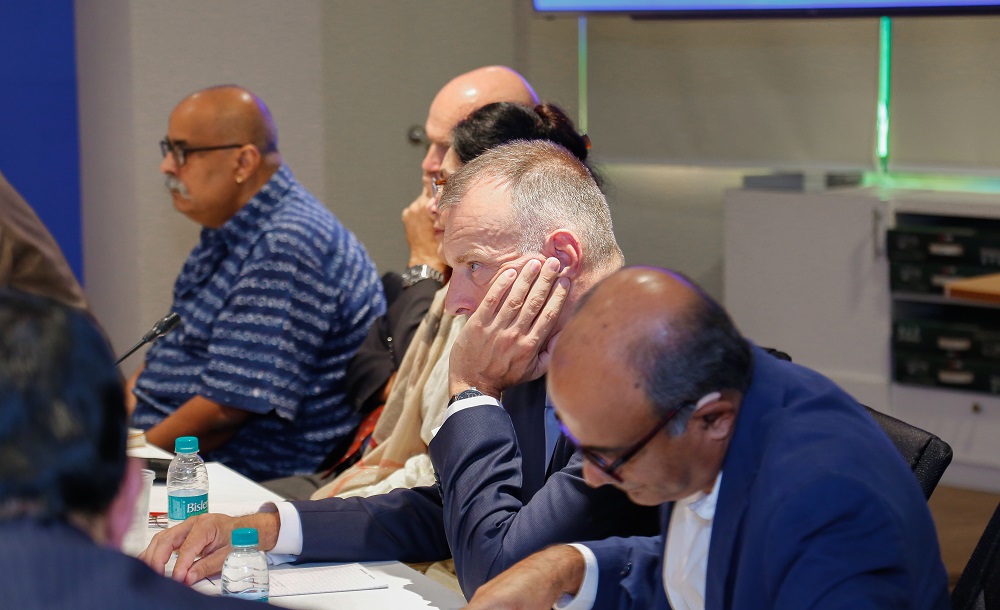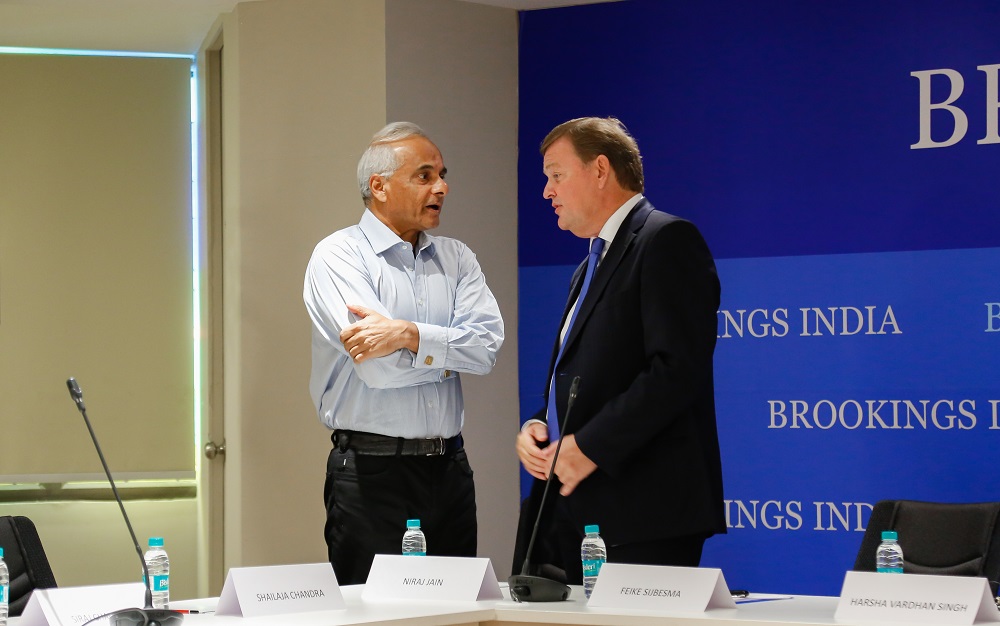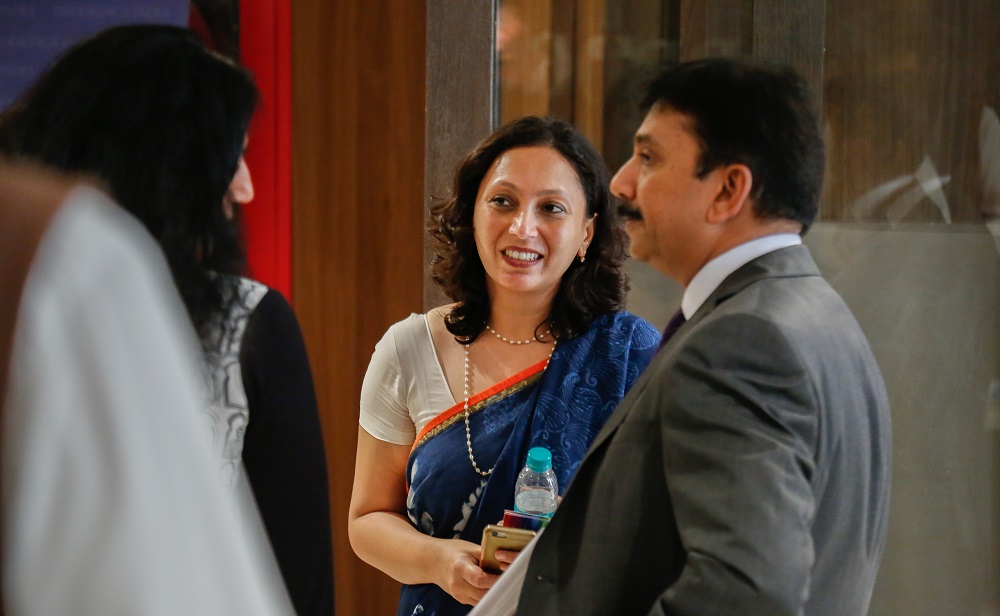

1:30 am IST - 3:00 am IST
Past Event
Content from the Brookings Institution India Center is now archived. After seven years of an impactful partnership, as of September 11, 2020, Brookings India is now the Centre for Social and Economic Progress, an independent public policy institution based in India.














Event Report
By Ramandeep Singh
Brookings India hosted a private roundtable discussion on Nutrition in India and the Role of PPPs on 26th September 2016, comprising senior representatives from government, academia, and the corporate sector. The lead discussants included Ashish Bahuguna (Chairman, FSSAI) and Feike Sijbesma (Chairman, DSM), and the discussion was moderated by Harsha Vardhana Singh, Executive Director at Brookings India. The roundtable discussed the pernicious, often invisible issue of malnutrition and ‘hidden hunger’ in India, the Government’s existing policy framework to deliver universal, rights-based nutrition interventions, and the role of the private sector to fill delivery gaps using a targeted, evidence-based approach. The policy-relevant time frame of the first 1,000 days of a child’s life – from conception to two years of age – framed the discussion given overwhelming evidence that 50% of the growth failure that gets accrued by two years of age occurs in the womb owing to poor nutrition of the mother (UNICEF, 2015).
The scale of malnutrition in India constitutes a public health crisis, which not only violates a fundamental right of humanity, but also undermines significant advances made in economic, social, and cultural indicators. An investment in nutrition is one of the most compelling economic investments, not to mention the substantial humanitarian returns: for every $1 invested in nutrition, a country can get $16 in returns (GNR, 2016). However, despite moderate progress over the past two decades, including the significance of the National Food Security Act 2013, which enshrines the basic right to food in law, nutrition has failed to attract priority status in the Government’s health agenda. More specifically, the current institutional structure has so far failed to correctly map the time frame for focused intervention, and state spending directed at nutrition and micronutrient supplementation (targeted at the most disadvantaged communities) continues to be low. These challenges are compounded by the continued lack of clarity in identifying the nodal ministry from which to coordinate the Government’s various nutrition programmes, including the Integrated Child Development Scheme (ICDS) and the National Rural Health Mission (NRHM). With current interventions retaining a focus on addressing malnutrition post-birth, the importance of intervening during the first 1,000 days of a child’s life cannot be overemphasised.
In the face of the challenge of (A)spirations (of people wanting a nutritious diet), (A)ffordability (of a diet that is nutrient-rich), and (A)vailability (of nutritious food and supplements), there is significant potential to incentivise the production of nutritionally-rich foods across the value chain. Of the list of available interventions, food fortification of relevant staples has a particularly important role to play, yet the solution remains grossly underutilised, being limited at present to the mandatory iodisation of salt. Given recognition of the scalable potential of this cost-effective intervention, the FSSAI has been working with a range of stakeholders to formulate draft standards for fortification of food grains such as wheat, flour, and rice, which will add to the nutrient value of food intake. Additional proposals under consideration include making mandatory the double fortification of salt (with iodine and iron), and the fortification of edible oils. Food fortification also represents an opportunity ripe for private sector collaboration, especially in the role for public-private partnerships (PPPs) to introduce the appropriate technology (for making nutritious food affordable), boosting the low levels of nutrition awareness in urban and rural communities, and supplementing government delivery systems.
Given the multiple contributing factors to the malnutrition problem, it is also crucial to leverage complementarities with cross-sectoral interventions. These should take the form of harnessing linkages with water, sanitation, and hygiene (WASH) initiatives (to discourage unsanitary practices such as open defecation), and further strengthening education and counselling on issues such as antenatal care and sex education (to reduce cases of unwanted births, and encourage family planning). In most cases however, inefficiencies and constraints in service delivery remain a challenge, which is particularly severe in the Indian context. Multi-sectoral partnerships are of critical importance in plugging delivery gaps: take for instance, DSM’s partnership with the Government of Rwanda, the UN World Food Programme (WFP), and the Clinton Health Access Initiative (CHAI) to develop and distribute innovate, nutrient-rich cereals to improve maternal and infant nutrition in Rwanda. With the trend towards packaged food moving into the consumption basket of rural households, there exist increasing opportunities for the private sector to engage in food distribution and food fortification, provide micronutrient supplementation, and promote dietary diversification. There is potential for this engagement to also take the form of private-private partnerships, which involve leveraging the power of industry networks to tackle public policy challenges.
In light of evidence highlighting significant state-level disparities in government delivery mechanisms (involving Anganwadi Centres, Public Distribution System etc.), greater participation of stakeholders at the community-level is also required to overcome both, the failure of state institutions in catering for the most vulnerable, and the limitations of the market in meeting the needs of the poor. In this context, civil society and other community institutions have an important role in promoting efficiency in last-mile delivery. These institutional limitations are compounded by the scarcity of information channels that have a mandate to communicate simple and timely information about the importance of nutrition to pregnant and lactating mothers. While Anganwadi Centres represent an appropriate platform for such engagement, common people do not understand complex communication. This reinforces the need for private sector outreach interventions aimed at spreading awareness about the importance of the first 1,000 days of a child’s life to households at the bottom of the socio-economic pyramid.
Looking ahead, the strategy to meet the malnutrition challenge must shift the policy focus from the national to the district and sub-district level. Sensible and effective policy must be based on evidence, both existing and new. There is a scarcity of studies that attempt to compute the monetary loss incurred due to malnutrition in India, and others that aim to draw lessons from successful policy interventions in specific Indian states. Potentially, randomised control trials (RCTs) might be conducted to identify cost-effective nutrition interventions at the district-level such that these can be scaled-up. There is also a pressing need to evaluate the institutional framework through which government nutrition interventions operate. In this area, research has many low-hanging fruit to harvest – these include better understanding how targeting and implementation can be improved in government programmes (ICDS, NHRM etc.), developing a framework for community-level institutions, and identifying the most appropriate mechanism for private sector engagement. In the long-term, both, policy targeting and implementation, and the level of stakeholder engagement must undergo a paradigm shift if India is to succeed in matching its social welfare gains with its economic achievements.
Like other products of the Brookings Institution India Center, this article is intended to contribute to discussion and stimulate debate on important issues. The views are of the author(s) and discussants(s). Brookings India does not have any institutional views.
Event Announcement
Brookings India is organising an expert roundtable discussion to address nutritional concerns in India and relevant interventions to improve the situation in this critical public policy area.
It is widely accepted and understood that under-nutrition in children has significant negative consequences for the child’s health, both immediate and longer term. Severe forms of under-nutrition like stunting contribute directly to child disease and mortality. It is also generally established that under-nutrition has a significant adverse effect on the formation of human capital and social and economic development. More recent research indicates that timing of nutrition is critical to neural development, and that weight gain in the first two years is an important predictor of later schooling outcomes. Therefore, a need for a significant shift in focus to the first 1000 days of a child’s life (including the pregnancy and lactating mothers) has been recognised within the development community.
The large scope of this issue implies a very important role for both the government and the private sector to work together in order to effectively address this crucial problem within an early timeframe. Thus, experience of PPPs in this context, and lessons for policy drawn from this experience, are crucial for improving the national effort to address the issue of nutrition provided during the crucial period of first 1000 days of a child’s life.
The central focus of the roundtable at Brookings India is to discuss the lessons drawn from the recent research evidence on this important topic and to brainstorm about potential interventions. The group consists of experts from government, academia, media and the corporate sector.

Rahul Tongia, Anurag Sehgal, Puneet Kamboj
2020
Online Only
3:00 am - 4:40 am IST

Saneet Chakradeo
August 18, 2020